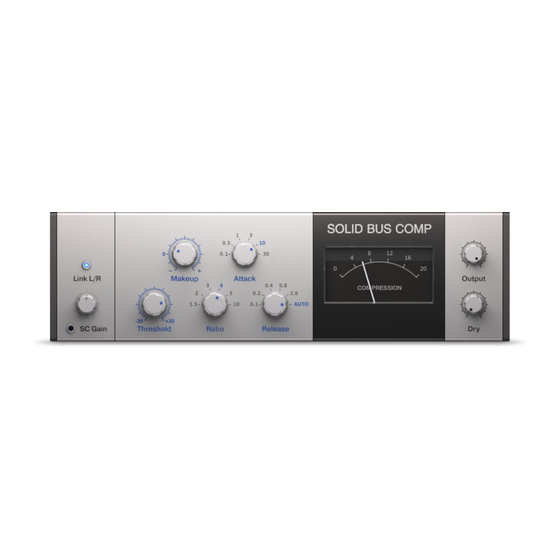Table of Contents
Advertisement
Advertisement
Table of Contents

Subscribe to Our Youtube Channel
Summary of Contents for Native Instruments SOLID MIX Series
- Page 1 Manual...
- Page 2 The information in this document is subject to change without notice and does not represent a commitment on the part of Native Instruments GmbH. The software described by this docu- ment is subject to a License Agreement and may not be copied to other media. No part of this...
- Page 3 Contact Germany Native Instruments GmbH Schlesische Str. 29-30 D-10997 Berlin Germany www.native-instruments.de Native Instruments North America, Inc. 6725 Sunset Boulevard 5th Floor Los Angeles, CA 90028 www.native-instruments.com © Native Instruments GmbH, 2012. All rights reserved.
-
Page 4: Table Of Contents
Table of Contents Table of Contents Welcome to SOLID BUS COMP ..................5 What Is a Compressor? ....................... 5 1.1.1 Main Compression Parameters .................. 6 1.1.2 Other Compression Parameters and Features ............6 1.1.3 What Is a Bus Compressor? ..................7 The SOLID BUS COMP ......................... -
Page 5: Welcome To Solid Bus Comp
Welcome to SOLID BUS COMP What Is a Compressor? Welcome to SOLID BUS COMP SOLID BUS COMP brings the stereo bus compressor of one of the most renowned studio mix- ing consoles of all times into your studio by way of FX Framework. What Is a Compressor? Technically speaking, a compressor is an audio processing unit that reduces the dynamic range of an incoming signal, i.e. -
Page 6: Main Compression Parameters
Welcome to SOLID BUS COMP What Is a Compressor? Using compression is a fine art: You can easily destroy your sound if you don’t carefully set the compression parameters! For each purpose, specific settings are required. A good understand- ing of each parameter’s effect, together with experience gained by using the compressor, will allow you to achieve great results! In addition to the above listed common applications there is room for your own experiments, so feel free to use your compressor in a way not listed here. -
Page 7: What Is A Bus Compressor
Welcome to SOLID BUS COMP What Is a Compressor? Similarly, the release time can define how long it takes for the active compressor to return to its standby state after the signal level has fallen below the threshold level. The right settings for attack and release time strongly depend on both the current purpose of the compression and the kind of instrument that you are working on! Side-Chain Input Every compressor uses a detector to decide when to kick in. -
Page 8: The Solid Bus Comp
Welcome to SOLID BUS COMP The SOLID BUS COMP The SOLID BUS COMP Originally released in the mid-1970s, the analog mixing console that inspired the SOLID MIX SERIES soon became the central element in many of the greatest studios around the world. Claiming to be the mixer behind more platinum selling albums than all other consoles com- bined, this mixing console literally contributed to the sound of the 1980s. -
Page 9: Using The Solid Bus Comp
Using the SOLID BUS COMP The Menu Bar Using the SOLID BUS COMP The Menu Bar At the very top of the SOLID BUS COMP interface, you will see the Menu bar. This is primarily used for saving and loading presets, but also has a few other functions. The Menu bar is located at the top of the interface. - Page 10 Using the SOLID BUS COMP The Menu Bar If you wish to remove a preset you no longer want, you can delete it by selecting Delete from the File menu. Please note: you are not able to delete factory content. Loading Presets In the center part of the Menu bar, you will see the Preset menu.
-
Page 11: The Main Interface
▪ Open Manual: opens this PDF document for reference. ▪ Visit Solid Bus Comp on the web: opens your default web browser and takes you to the SOLID BUS COMP page on the Native Instruments website. The Main Interface This section describes the SOLID BUS COMP interface and controls in detail. - Page 12 Using the SOLID BUS COMP The Main Interface SC Gain button: Enables/disables the side-chain input. The side-chain circuitry allows you to feed the compressor’s detector with another control signal instead of the input signal itself (see 1.1.2 for more info on this). SC Gain knob: Controls the input gain of the side-chain signal —...
- Page 13 Using the SOLID BUS COMP The Main Interface ↑1.1.2, Other Compression Parameters and Features for more general information on the attack and release time. COMPRESSION meter: Allows you to visually monitor the current amount of applied com- pression in real-time. (10) Output knob and (11)







Need help?
Do you have a question about the SOLID MIX Series and is the answer not in the manual?
Questions and answers